
For SpaceUpClose.com & RocketSTEM
KENNEDY SPACE CENTER, FL – A 7x recycled SpaceX Falcon 9 rocket launched a commercial Dragon cargo spacecraft carrying over three tons of groundbreaking NASA science and crucial crew supplies and spacesuit hardware Tuesday evening, March 14, to the International Space Station (ISS) into crystal clear nighttime skies from Florida’s Space Coast.
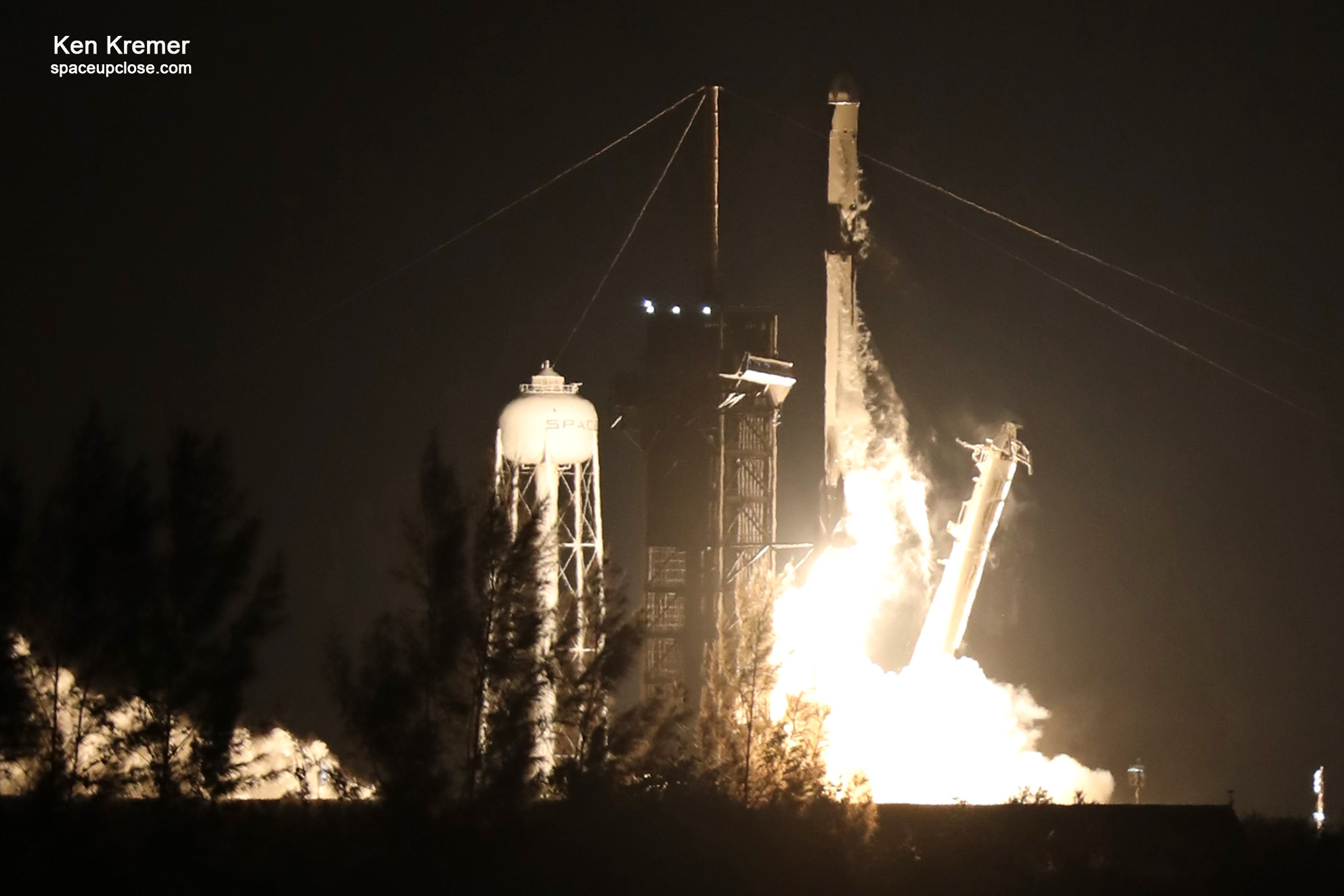
The NASA SpaceX resupply launch to the ISS was an absolute delight for spectators gathered around the space port for the early evening blastoff sporting mild temperatures as it soared aloft on a northeasterly trajectory along the US Atlantic Coast away from Florida at an inclination of 51.6 degrees.
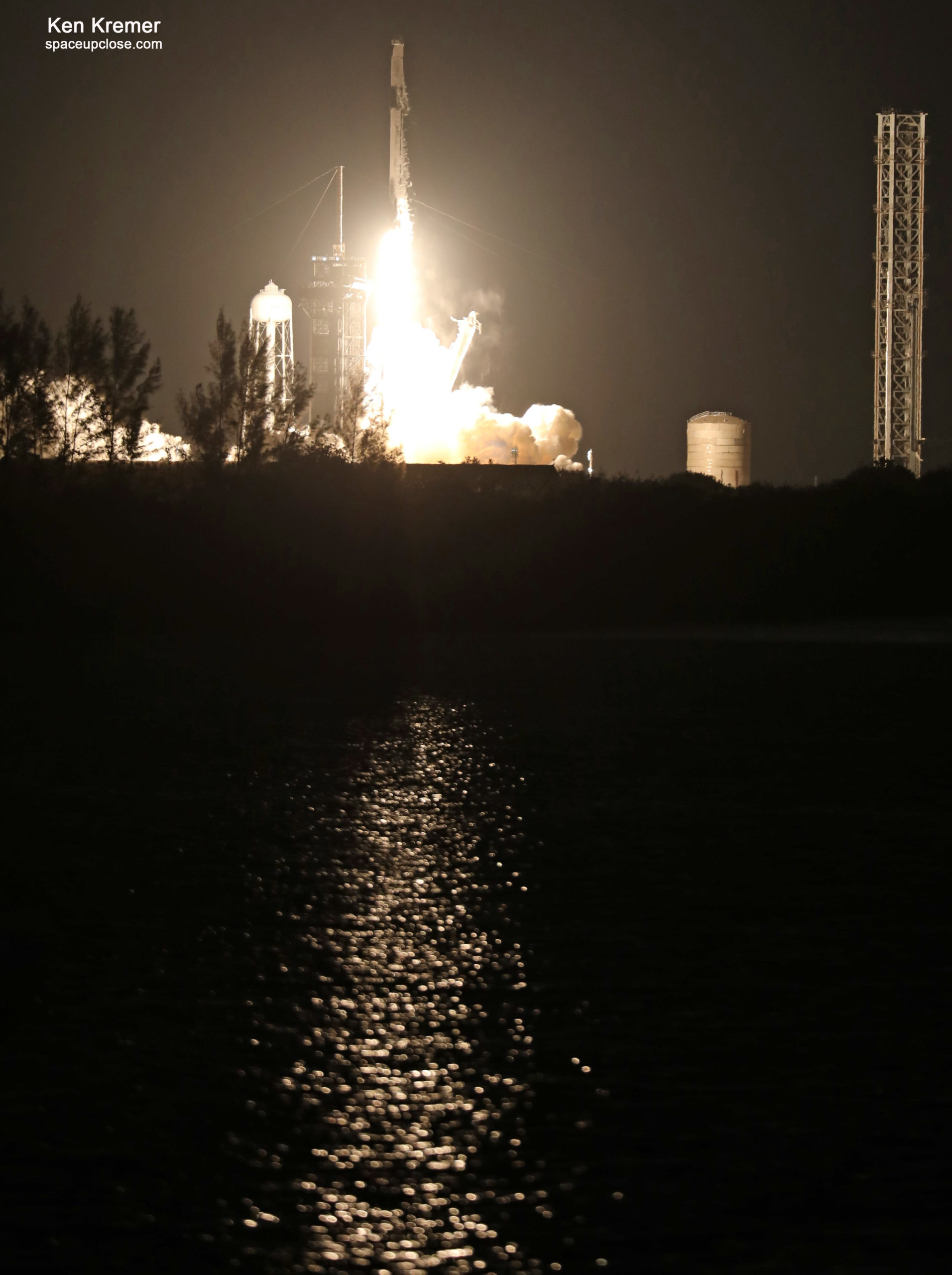
The 215-foot-tall (65-meter) NASA SpaceX Falcon 9 and Cargo Dragon lifted off right on time on SpaceX’s 27th NASA contracted Commercial Resupply Services (CRS-27) mission to the International Space Station since 2012 during an instantaneous launch window at 8:30 p.m. EST Tuesday, March 14, (0030 GMT Wednesday) from historic Launch Complex 39A (LC-39A) at the Kennedy Space Center (KSC) in Florida.

Dragon is packed with nearly 6,300 pounds of science experiments, research investigations, crew supplies, equipment, food, water and a refurbished EMU spacesuit bound for the orbiting microgravity research outpost.
Cargo Dragon is scheduled to dock at the forward port on the Harmony module about 36 hours after liftoff after a carefully choreographed series of thruster maneuvers.

Fresh food is also on board for the 7 person crew living and working on the station – namely blueberries, apples, cherry tomatoes, and four kinds of cheese.
This is the 2nd SpaceX Dragon to dock at the ISS this month following the Crew-6 astronaut Dragon Endeavour spaceship.
The research includes medical investigation into heart cells and heart organoids with 3D cultured cardiac muscle tissue to assess human cardiac function in microgravity bacterial biofilm formation and antimicrobial properties of different metal surfaces under spaceflight conditions, origin of life study into whether terrestrial life can survive in space, a student experiment aimed at enabling astronauts to use an aluminum monopod fitted with a camera shoe and ball clamp to help capture stable video and much more
Also flying on Dragon is the agency’s Educational Launch of Nanosatellites (ELaNa) 50 mission, which will deliver two CubeSats to low-Earth orbit to conduct science investigations of their own. Read about them here.
Curious about the science and research en-route to the @Space_Station? More on the new investigations heading to space: https://t.co/zodFnbGONG
— NASA (@NASA) March 15, 2023
The path to launch was cleared following the successful undocking and return of NASA’s SpaceX Crew-5 on Saturday, March 11.
The launch was carried live on NASA Television, the NASA app, and the agency’s website.
Liftoff! Science, supplies & snacks are flying to the @Space_Station. @SpaceX #CRS27 is carrying blueberries, apples, cherry tomatoes, and four kinds of cheese. All the makings of a space charcuterie board? If you were going on a trip to space, what snacks would you want to take? pic.twitter.com/4bpGySxUJ9
— NASA (@NASA) March 15, 2023
The cargo spacecraft is scheduled to autonomously dock with the space station at 7:52 a.m. EDT Thursday, March 16.
Coverage of arrival will begin at 6:15 a.m. EDT on NASA Television, the agency’s website, and the NASA app.
The spacecraft will dock autonomously to the forward-facing port of the station’s Harmony module – just vacated by the Crew-5 Dragon spacecraft.
Dragon is expected to spend about a month attached to the orbiting outpost before it returns to Earth with research and return cargo, splashing down off the coast of Florida.
This was the seventh flight of the first stage booster B1073.7 supporting this mission, which previously launched Hispasat Amazonas Nexus, SES-22, ispace’s HAKUTO-R Mission 1, and three Starlink missions.
Following stage separation, Falcon 9 landed on the ‘A Shortfall of Gravitas’ (ASOG) droneship in the Atlantic Ocean some eight minutes after liftoff.
Falcon 9’s first stage has landed on the A Shortfall of Gravitas droneship pic.twitter.com/IKVtXDPaIy
— SpaceX (@SpaceX) March 15, 2023
CRS-27 is the third flight for this Dragon cargo spacecraft, which previously flew CRS-22 and CRS-24 to the space station.

The SpaceX Dragon spacecraft will deliver over 60 new research projects including “new science investigations, supplies, and equipment for the international crew, including NASA’s HUNCH Ball Clamp Monopod, a student manufactured project that can make filming in space easier, and the JAXA (Japan Aerospace Exploration Agency) Tanpopo-5 investigation which studies the origin, transportation, and survival of life in space and on extraterrestrial planets.”
“Dragon will also deliver the final two experiments from the National Institutes for Health and International Space Station National Laboratory’s Tissue Chips in Space initiative. Both studies, Cardinal Heart 2.0 and Engineered Heart Tissues-2, use small devices containing living cells that mimic functions of human tissues and organs to advance the development of treatments for cardiac dysfunction,” says NASA.

From NASA – Among the science experiments Dragon is delivering to the space station for NASA and its partners are:
3D Heart Cells, Tissue
The first Cardinal Heart investigation conducted aboard the space station showed that four weeks of microgravity exposure can cause significant changes in heart cell function and gene expression. Researchers concluded that these changes could lead to long-term medical issues. The Cardinal Heart 2.0 experiment builds on these results, using heart organoids, 3D structures made up of all the different types of cells, to test whether clinically approved drugs reduce these microgravity-induced changes in heart cell function. Results could support the development of effective drug combinations to improve the health of astronauts and patients on Earth.
The Engineered Heart Tissues-2 study continues work with 3D cultured cardiac muscle tissue to assess human cardiac function in microgravity. Previous work with 3D cultures in space detected changes at the cellular and tissue level that could provide early indication of the development of cardiac disease. This investigation tests whether new therapies prevent these adverse spaceflight effects from occurring. The model used in this study has potential use in drug development and other applications related to diagnosing and treating cardiac dysfunction on Earth.
Cardinal Heart 2.0 and Engineered Heart Tissues-2 are the final two experiments comprising the National Institutes for Health and International Space Station National Lab’s Tissue Chips in Space initiative. Researchers hope to learn more about the impact of microgravity on human health and disease, and translate that understanding to improved human health on Earth.
Student Ball Clamp Monopod Project
NASA’s HUNCH (High school students United with NASA to Create Hardware) program enables students to fabricate real-world products for NASA as they apply their science, technology, engineering, and mathematics skills. The HUNCH Ball Clamp Monopod attempts to address astronaut comments on the difficulty of positioning video or still cameras in the middle of a module. The student-manufactured project is composed of an aluminum monopod fitted with a camera shoe and ball clamp that can be attached to a standard space station handrail. The ball clamp serves as a pivoting platform for photography and video.
Liquid Life Support Systems
Because microgravity makes it difficult to control the flow of liquids, the space station has been unable to take advantage of carbon dioxide removal methods that use specialized liquids. Liquid-based carbon dioxide removal systems such as those on submarines offer higher efficiency than other types of systems. The CapiSorb Visible System study demonstrates liquid control using capillary forces, the interaction of a liquid with a solid that can draw a fluid up a narrow tube, which are characteristic of liquids that can absorb carbon dioxide. This is an important consideration for future longer-duration space missions where improved efficiency will support crews over many months or years.
Bacterial Biofilms
Microbial biofilms are combinations of microorganisms that embed themselves in a self-produced slimy matrix. Biofilms are of concern for spaceflight because they can cause damage to equipment, are resistant to cleaning agents, and can harbor microorganisms that might cause infections. The ESA (European Space Agency) Biofilms investigation studies bacterial biofilm formation and antimicrobial properties of different metal surfaces under spaceflight conditions. Antimicrobial surfaces that can inhibit biofilm growth, such as copper and its alloys with and without laser surface treatment, are used in this study. This project provides additional information to help develop suitable antimicrobial surfaces for future spacecraft.
Lifeform Origins, Survival
An investigation from JAXA (Japan Aerospace Exploration Agency) known as Tanpopo-5 could provide insight into whether terrestrial life can survive in space and help scientists understand the key ingredients that sparked life on Earth. The experiment studies the response to space exposure in radiation-resistant microbes, moss spores, and biochemical compounds including amino acids. Amino acids have been detected in extraterrestrial bodies such as meteorites and are possible precursors to life on Earth. Tanpopo-5 follows four earlier experiments which could all inform strategies to protect other planets from contamination by humans and for returning samples from other planets safely to Earth.
These are just a few of the hundreds of investigations currently conducted aboard the orbiting laboratory in the areas of biology and biotechnology, physical sciences, and Earth and space science. Advances in these areas will help keep astronauts healthy during long-duration space travel and demonstrate technologies for future human and robotic exploration beyond low-Earth orbit to the Moon and Mars.

Crew-6 just arrived at the ISS a week ago after launching on March 2 and Crew-5 departed over the weekend
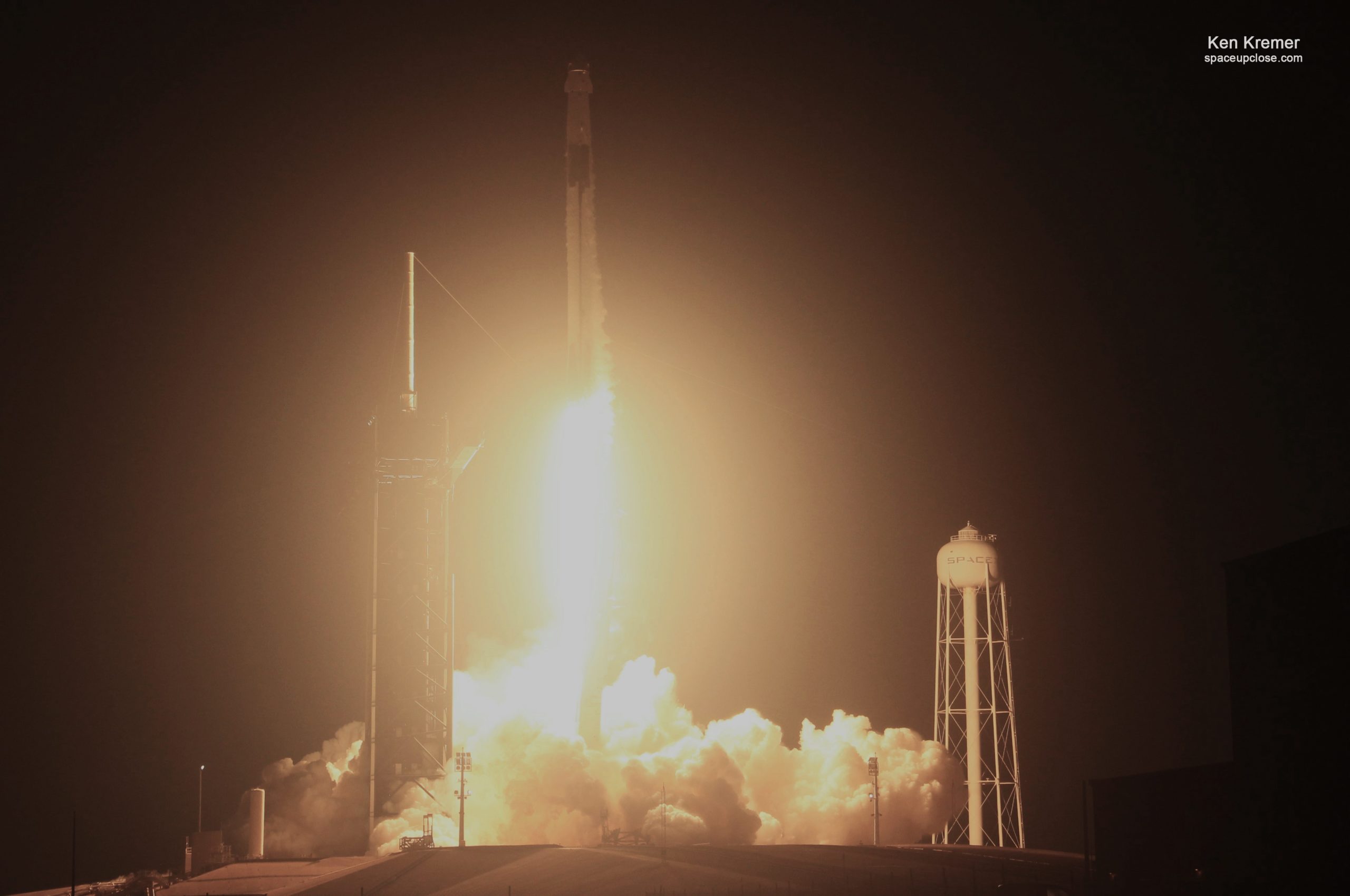
A busy time of comings and goings is ahead for the ISS crew in the next few months
After CRS-27 Dragon departs in a month the 1st crewed Boeing Starliner with 2 NASA astronauts is scheduled to dock at the same forward port on the CFT mission for aout a week long mission.
Liftoff is NET April 30, NASA told Space UpClose
Thereafter another short duration mission sponsored by Axiom Space will launch NET May on the Ax-2 flight with 4 astronauts
Fun Facts about CRS-27
- This is the seventh flight of this SpaceX Falcon 9 rocket
- Launch marks SpaceX’s second Dragon launch of 2023 and the company’s 216th mission overall
- This is the third flight for this uncrewed Dragon spacecraft
- Teams recovered the Falcon 9’s first stage following its return to Earth –this was the 178th recovery of an orbital class rocket
- Recovery operations are being managed by an all-female crew stationed on SpaceX’s drone ship “A Shortfall of Gravitas” off the coast of Florida
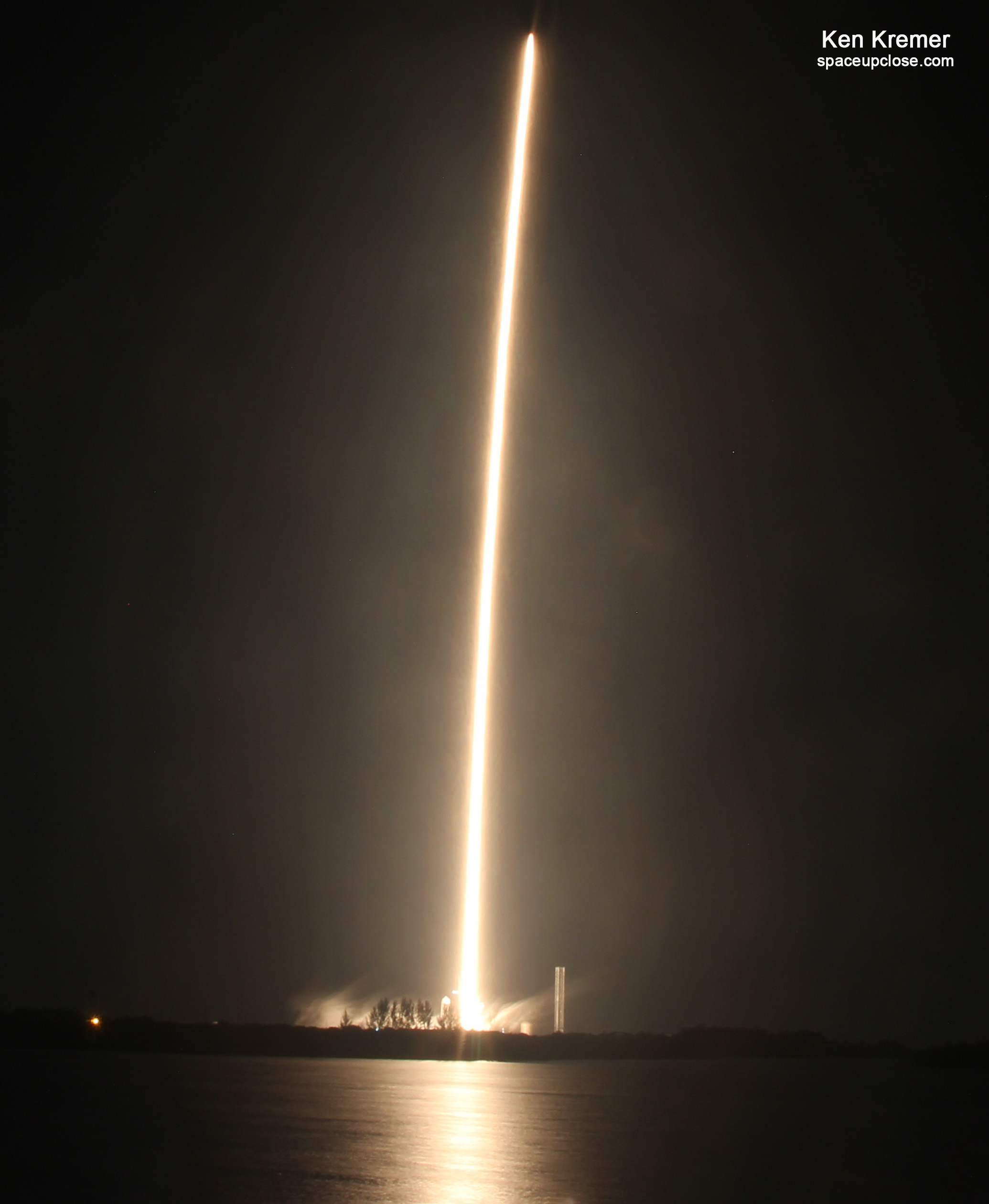
Here’s a full look at the CRS-27 countdown and ascent milestones. All times (EDT) are approximate:
COUNTDOWN
Hr/Min/Sec Event
– 00:38:00 SpaceX Launch Director verifies go for propellant load
– 00:35:00 RP-1 (rocket grade kerosene) loading begins
– 00:35:00 1st stage LOX (liquid oxygen) loading begins
– 00:16:00 2nd stage LOX loading begins
– 00:07:00 Falcon 9 begins prelaunch engine chill
– 00:05:00 Dragon transitions to internal power
– 00:01:00 Command flight computer to begin final prelaunch checks
– 00:01:00 Propellant tanks pressurize for flight
– 00:00:45 SpaceX Launch Director verifies go for launch
– 00:00:03 Engine controller commands engine ignition sequence to start
– 00:00:00 Falcon 9 liftoff
LAUNCH, LANDING, AND DRAGON DEPLOYMENT
Hr/Min/Sec Event
00:01:12 Max Q (moment of peak mechanical stress on the rocket)
00:02:24 1st stage main engine cutoff (MECO)
00:02:28 1st and 2nd stages separate
00:02:35 2nd stage engine starts
00:05:44 1st stage entry burn begins
00:07:36 1st stage landing
00:08:38 2nd stage engine cutoff (SECO)
00:11:34 Dragon separates from 2nd stage
00:12:22 Dragon nosecone open sequence begins
MISSION STATS- from Spaceflight Now:
- 210th launch of a Falcon 9 rocket since 2010
- 220th launch of Falcon rocket family since 2006
- 7th launch of Falcon 9 booster B1073
- 3rd flight of Dragon capsule C209
- 180th Falcon 9 launch from Florida’s Space Coast
- 64th SpaceX launch from pad 39A
- 157th launch overall from pad 39A
- 7th launch of an upgraded Cargo Dragon vehicle
- 27th SpaceX cargo mission to the International Space Station
- 16th Falcon 9 launch of 2023
- 17th launch by SpaceX in 2023
- 13th orbital launch attempt based out of Cape Canaveral in 2023
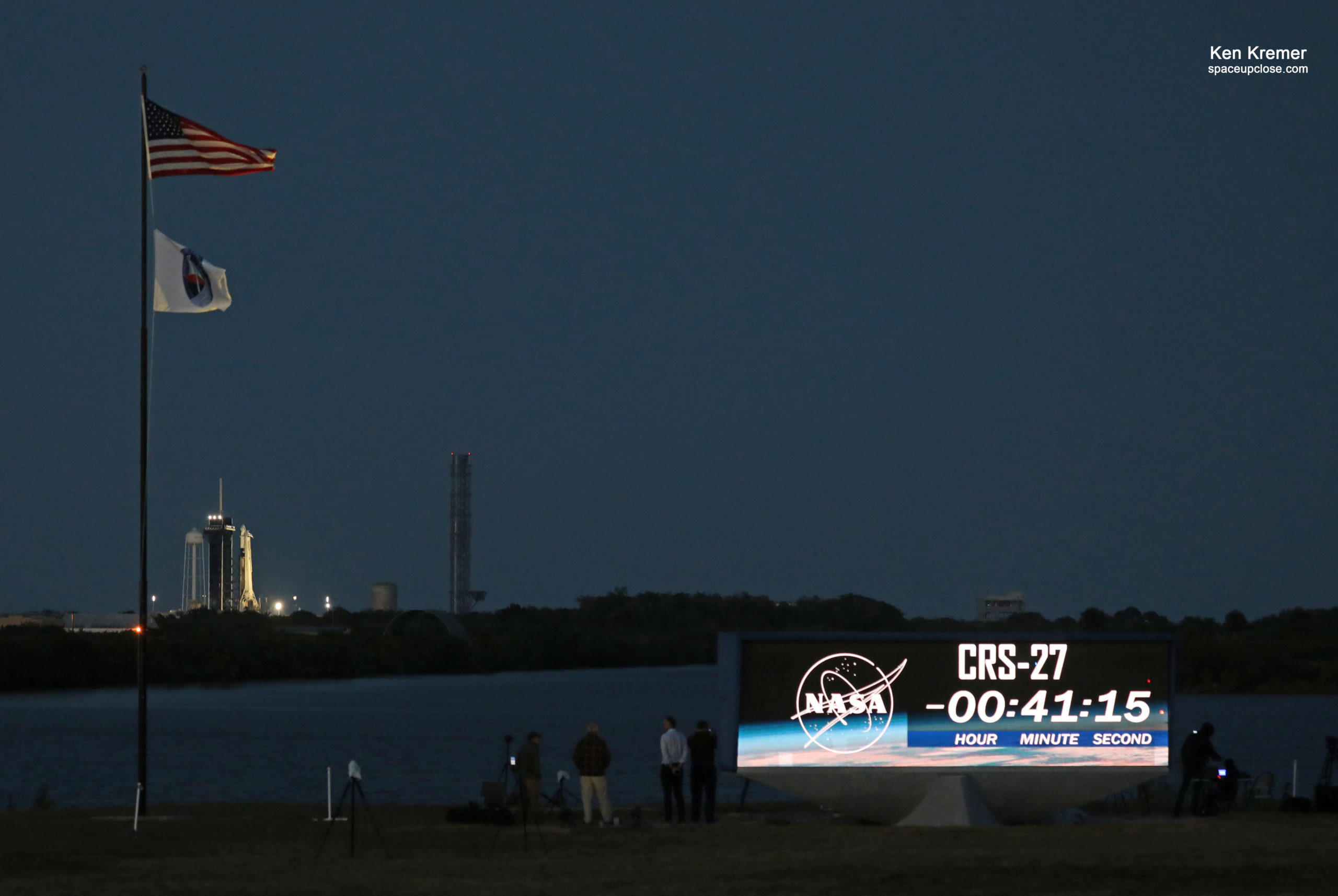
Watch Ken’s commentary about NASA. Project Artemis SLS and Orion, SpaceX Falcon Heavy, Crew-5 & 6, NASA SpaceX Crew & Cargo Dragons and more
Mar 17: Fox 35 News Orlando update about next Terran 1 launch attempt:
https://www.fox35orlando.com/news/new-launch-date-announced-for-first-3d-printed-rocket-from-florida

Mar16/17: WKMG CBS 6 Orlando News interview about Virgin Orbit pausing operations today and why this is not a good sign as they seek to enter the small satellite market with many competitors like Relativity Space Terran1 rocket trying 1st launch – as well as established competitors like SpaceX & RocketLab.
Mar 8/9: WFTV ABC News and Fox 35 New Orlando pre and post scrub interview about maiden Terran 1 launch attempt:

Mar 7: WFTV ABC News Orlando interview about upcoming maiden Terran1 launch by Relativity Space on Mar 8
Mar 6/7: WFTV ABC News Orlando interview about upcoming maiden #Terran1 launch by Relativity Space on Mar 8 from pad 16 CCSFS. Worlds 1st 3D printed rocket:
Mar 2: Fox 35 Orlando live interview about the Crew-6 mission launch to the ISS
Feb 26/27/28: On 3 local Networks CBS WKMG , ABC WFTV and Fox 35 Orlando -I did series of live and taped interviews pre and post scrub explaining why NASA SpaceX Crew6 astronaut launch to ISS was scrubbed at T Minus 2 minutes to keep the crew and rocket safe and what needs to be done to resolve the issue why TEA-TEB (triethylaluminum triethylboron) igniter fluid failed to fully load on Falcon 9 rocket
Feb 9/10: WFTV ABC News Orlando interview about SpaceX Starship successful static fire test of 31 Raptor engines at Boca Chica
Feb 8/9: WFTV ABC News Orlando interview about how NASA needs a definitive and fully funded plan to deorbit the ISS safely in case of an emergency and serious debris hit causing it to lose control b4 it’s terminated in 2030- in light of the recent Soyuz crew capsule leak from micrometeoroid impact
Jan 3/4: WFTV ABC News Orlando interview about Jan 3 SpaceX Transporter 6 launch – 1st of 2023 – and record setting year ahead with many exciting missions for NASA and private astronauts, science probes, mission, US Space Force, new rockets like ULA Vulcan & more!
Watch Ken’s continuing reports about Artemis, SpaceX missions, SLS, Orion and NASA missions, SpaceX Crew and Cargo Dragons, SpaceX Axiom, JWST, DART, Lucy Asteroid mission, GOES, SpaceX Starlink, Commercial Crew and Starliner and Crew Dragon, Blue Origin and Space Tourism, and onsite for live reporting of upcoming and recent SpaceX and ULA launches including Crew 1 & 2 & 3 & 4 & 5, ISS, Solar Orbiter, Mars 2020 Perseverance and Curiosity rovers, NRO spysats and national security missions and more at the Kennedy Space Center and Cape Canaveral Space Force Station.
Stay tuned here for Ken’s continuing Earth and Planetary science and human spaceflight news: www.spaceupclose.com – twitter @ken_kremer – email: ken at kenkremer.com
Dr. Kremer is a research scientist and journalist based in the KSC area, active in outreach and interviewed regularly on TV and radio about space topics.
………….
Ken’s photos are for sale and he is available for lectures and outreach events
Please consider supporting Ken’s work by purchasing his photos and/or donating at Patreon
https://www.patreon.com/kenkremer
Upcoming and recent space events and talks by Ken Kremer & Jean Wright
Jan 21-28: Carnival Cruise Ship Mardi Gras: “What Happening at NASA and Space Exploration” & SpaceX Falcon 9 Starlink 5-2 launch viewing party Jan 26
Jan 12, 2023: 10 AM at Westminster Retirement Center in Orlando/Winter Park, Florida: Presentation by Jean Wright – “Sew Sister to the Stars- How the Humble Art of Sewing Transformed the World of Flight”+ Artemis 1 Moon rocket update
Nov 29 at UCF, Orlando Florida: Presentation by Jean Wright – “Sew Sister to the Stars- How the Humble Art of Sewing Transformed the World of Flight”
Mar 1, 2, 12,13; Feb 4, 11, 24, 25, 26; Jan 7,11- 2023; from 7 to 9 PM Quality Inn, Titusville, FL: Join Ken and Jean for Artemis 1, Falcon Heavy and space mission and rocket launch outreach. Ask us anything. plus display our photos and space apparel items for sale





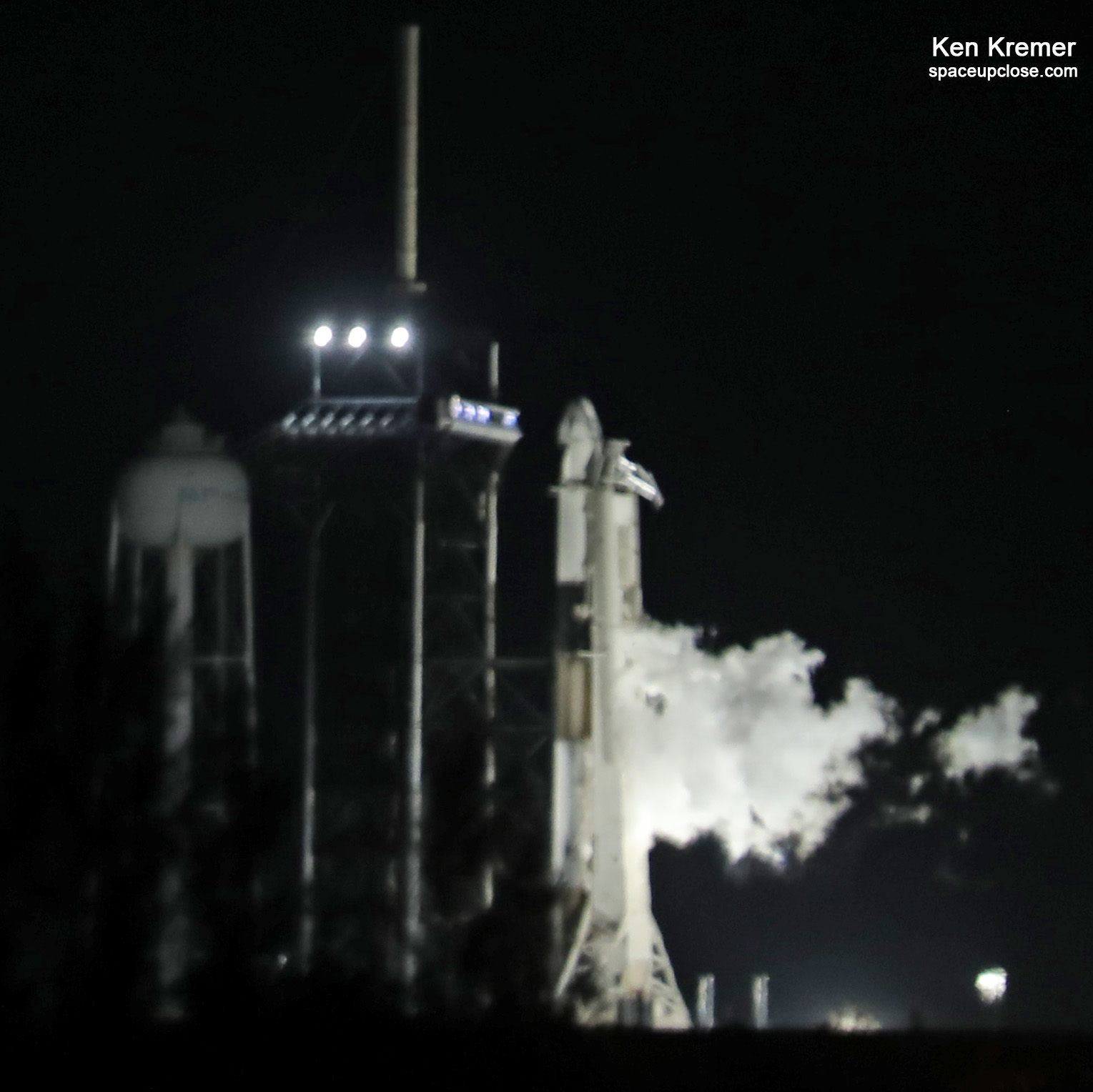
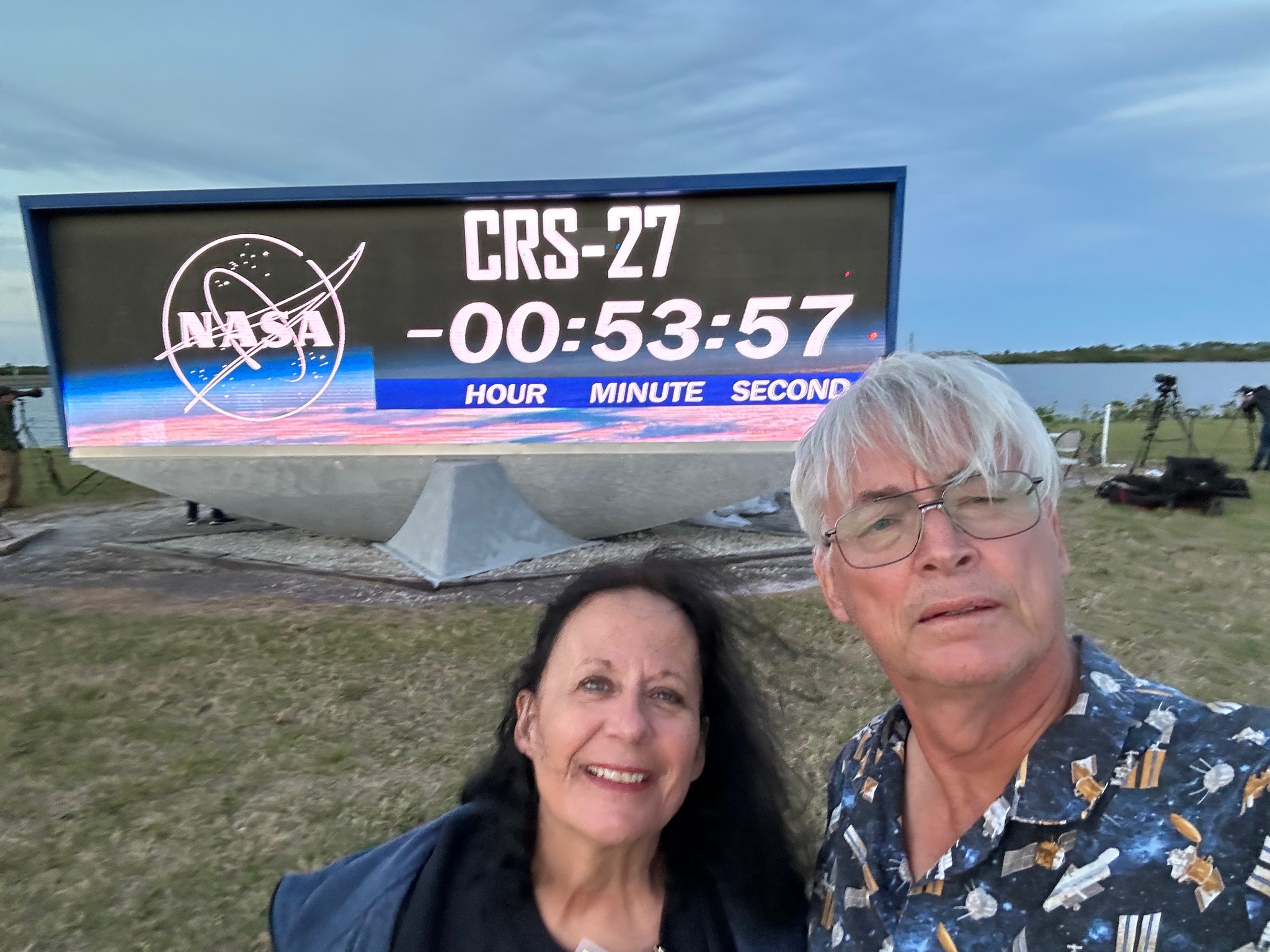


x



